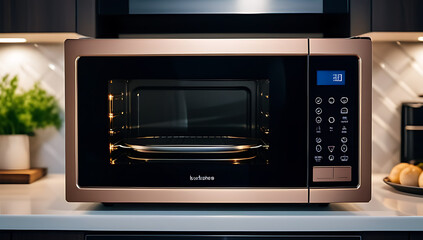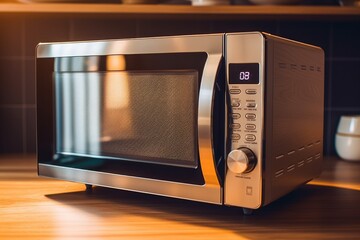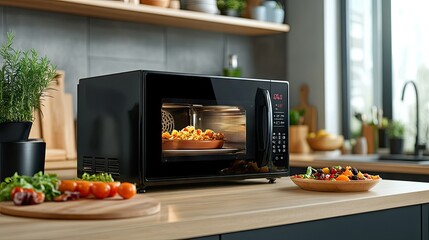MicroWave Oven Everything You Need to Know
Learn everything about microwave oven in this complete guide. Discover types, benefits, safety tips, and how to choose and maintain your microwave oven.
Introduction
A microwave oven is one of the most essential kitchen appliances in modern homes. It uses microwave energy to heat, cook, and defrost food quickly and efficiently. Unlike conventional ovens, it works faster and is easy to use. The microwave oven has completely transformed how we prepare meals daily. Its simple design and powerful functionality make it ideal for all types of cooking tasks. Additionally, microwave ovens save time, energy, and effort in the kitchen. Whether you want to reheat leftovers or cook a quick meal, the microwave oven makes life convenient.
How Does a Microwave Oven Work?
Understanding how a microwave oven works is simple yet fascinating. It produces microwaves using a component called the magnetron. These microwaves penetrate food and cause water molecules to vibrate rapidly. As a result, heat is generated, cooking the food from within. Unlike traditional ovens, which rely on outside heat, the microwave oven cooks evenly and quickly. This technology ensures efficiency without compromising taste or texture. Moreover, the rotating turntable inside helps distribute heat evenly across the food, avoiding cold spots. Therefore, the science behind the microwave oven is both practical and effective for everyday cooking.
History and Invention of Microwave Oven
Interestingly, the microwave oven was invented by accident. In 1945, Percy Spencer, an American engineer, discovered microwave heating when a candy bar in his pocket melted while working near radar equipment. This accidental discovery led to the development of the first microwave oven. The early models were large, expensive, and mainly used in commercial kitchens. However, as technology advanced, microwave ovens became smaller, affordable, and suitable for home use. Over time, manufacturers improved their features, making the microwave oven a household staple. Today, millions of people rely on microwave ovens worldwide.
Types of Microwave Ovens
There are different types of microwave ovens available to meet various cooking needs. Firstly, the solo microwave oven is perfect for basic tasks like reheating and defrosting. Secondly, grill microwave ovens include a grilling feature, ideal for browning and crisping food. Thirdly, convection microwave ovens combine microwave energy with convection heating. This type allows baking, roasting, and grilling in addition to regular microwave functions. Each type offers unique advantages, so choosing the right one depends on your cooking preferences. Consequently, understanding the types of microwave ovens helps you make an informed decision.

Common Features of a Microwave Oven
Modern microwave ovens come packed with many useful features. Most include adjustable power levels, allowing precise control over cooking intensity. Additionally, preset cooking programs make it easy to prepare specific foods like popcorn or pizza. Many microwave ovens have a defrost function that thaws frozen items quickly. Child safety locks prevent accidental operation, ensuring safe use. Furthermore, some advanced models offer grill and convection functions, expanding cooking possibilities. These features make the microwave ovens versatile and convenient. As a result, it has become indispensable in the kitchen.
Advantages of Using a Microwave Oven
The microwave ovens offers several significant advantages. Firstly, it cooks food much faster than conventional ovens, saving valuable time. Secondly, it is energy-efficient, using less electricity compared to other cooking methods. Thirdly, microwave ovens are easy to operate, making them ideal for people of all ages. Additionally, they retain more nutrients in food because of shorter cooking times. Moreover, microwave ovens are compact, taking up minimal kitchen space. Ultimately, the convenience, speed, and efficiency of a microwave ovens make it an essential kitchen appliance for busy households.
Safety Tips for Microwave Oven Use
Although microwave ovens are safe, following proper guidelines is crucial. Always use microwave-safe containers, as metal or aluminum can cause sparks. Avoid operating the microwave ovens when empty, as it may damage the magnetron. Keep the interior clean to prevent food buildup, which can affect performance. Use oven mitts when handling hot containers to avoid burns. Allow food to stand after heating, ensuring heat distributes evenly. Additionally, never overheat liquids, as they may suddenly boil over. By following these safety tips, you can use your microwave ovens confidently and safely.
How to Choose the Right Microwave Oven
Selecting the right microwave ovens depends on several factors. Consider the size based on your kitchen space and family needs. Power wattage also matters; higher wattage means faster cooking. Check for essential features like auto-cook menus, defrost settings, and safety locks. Decide if you need advanced functions like grilling or convection. Additionally, consider your budget and preferred brand reputation. Reading reviews and comparing models helps you make an informed decision. Therefore, choosing the right microwave ovens ensures you get the best value and functionality.
Microwave Oven Maintenance Tips
Proper maintenance extends the life of your microwave ovens. Start by regularly wiping the interior with a damp cloth to remove spills. Clean the turntable and door seals to ensure smooth operation. Avoid slamming the door, as it may damage the latch mechanism. Check the power cord and plug for any signs of wear. Additionally, avoid using harsh chemicals when cleaning; mild soap works best. Conduct occasional professional servicing if needed. By following these simple maintenance tips, your microwave ovens remains efficient and reliable for years.

Foods Best Cooked in a Microwave Oven
A wide variety of foods cook exceptionally well in a microwave oven. You can quickly reheat leftovers without drying them out. Microwave ovens are perfect for steaming vegetables, retaining their nutrients and vibrant colors. Popcorn, one of the most popular snacks, cooks effortlessly. Additionally, you can bake simple cakes and muffins using a microwave ovens. Preparing oatmeal, soups, and pasta dishes becomes much faster. Overall, the microwave ovens handles both quick meals and snacks with ease, making it incredibly versatile.
Microwave Oven Cooking Techniques
Mastering microwave ovens cooking techniques enhances your experience. Start by cutting food into uniform pieces for even cooking. Stirring food midway through cooking prevents hot spots. Cover dishes with a microwave-safe lid or wrap to retain moisture. Use lower power settings for delicate foods. Always follow recommended cooking times in recipes. Allow food to rest after heating, as it continues to cook from residual heat. By applying these techniques, you achieve delicious results consistently with your microwave ovens.
Difference Between Microwave Oven and Conventional Oven
There are notable differences between a microwave ovens and a conventional oven. A microwave oven uses electromagnetic waves to heat food quickly, while a conventional oven relies on external heat. Microwave ovens are faster and energy-efficient, perfect for reheating and simple cooking. Conversely, conventional ovens excel in baking, roasting, and complex recipes. However, modern microwave ovens with convection settings bridge this gap. Ultimately, both appliances serve distinct purposes, but the microwave ovens stands out for convenience and speed.
Environmental Impact of Microwave Ovens
Interestingly, microwave ovens are considered more environmentally friendly than some traditional cooking methods. They consume less electricity due to shorter cooking times, reducing overall energy usage. Additionally, microwave ovens emit fewer greenhouse gases compared to gas stoves. However, proper disposal of old microwave ovens is important to minimize electronic waste. Recycling programs ensure responsible handling of components. By using a microwave ovens wisely, you contribute to a more sustainable kitchen environment.
Cleaning Your Microwave Oven Effectively
Keeping your microwave ovens clean is essential for hygiene and performance. Start by removing the turntable and washing it with warm, soapy water. Wipe the interior walls using a cloth and mild detergent. For stubborn stains, heat a bowl of water with lemon slices inside; steam loosens grime. Avoid using abrasive cleaners, as they may damage surfaces. Regularly clean the door seals to maintain a tight closure. A clean microwave ovens ensures better cooking results and prevents odors.
Popular Microwave Oven Brands
Several trusted brands manufacture high-quality microwave ovens. Samsung offers innovative models with advanced features. LG is known for reliable and efficient designs. Panasonic microwave ovens provide excellent performance and durability. Whirlpool and IFB also produce versatile microwave ovens with multiple functions. Researching brand reputation, customer reviews, and warranty policies helps you choose the best option. Ultimately, investing in a reputable microwave oven brand ensures long-term satisfaction and reliability.

Troubleshooting Common Microwave Oven Issues
Occasionally, microwave ovens may encounter issues. If your microwave oven isn’t heating, check the door latch and power supply. Strange noises may indicate loose components or debris inside. A malfunctioning turntable may require repositioning or cleaning. If buttons become unresponsive, unplug and restart the appliance. Always consult the user manual for specific troubleshooting steps. When in doubt, contact professional service technicians. Addressing minor issues promptly keeps your microwave ovens functioning smoothly.
Microwave Oven Innovations and Future Trends
Microwave ovens continue to evolve with new innovations. Smart microwave ovens now integrate with mobile apps, allowing remote control and monitoring. Voice control features enhance convenience. Additionally, inverter technology improves even cooking by delivering consistent power. Eco-friendly designs focus on energy efficiency and recyclable materials. In the future, we can expect microwave to offer more customization, faster cooking times, and seamless integration with smart home systems. Consequently, the microwave remains at the forefront of kitchen technology.
Benefits of Microwave Oven in Busy Lifestyles
In today’s fast-paced world, the microwave oven proves invaluable. It allows quick meal preparation, ideal for busy individuals and families. Whether reheating breakfast or cooking dinner, the microwave saves time and reduces stress. Additionally, it simplifies meal planning and encourages healthier home-cooked meals. Its ease of use appeals to all age groups, from students to working professionals. Therefore, incorporating a microwave into your routine enhances efficiency and convenience.
Conclusion
To sum up, the microwave oven is a must-have kitchen appliance. Its speed, efficiency, and versatility make cooking easier and more enjoyable. From reheating leftovers to preparing full meals, it simplifies everyday tasks. Safety features, energy efficiency, and modern innovations further enhance its appeal. By understanding how to use and maintain your microwave, you maximize its benefits. Ultimately, no modern kitchen is complete without a reliable microwave.







